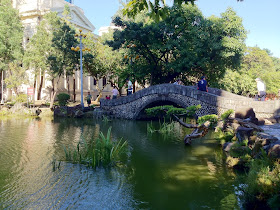In 1947, protests resulted in violent fighting by the government, and resulted in the deaths of 10,000 to 30,000 or more people. The park itself was established in 1908. The monument and renaming of the park to remember the event occurred in 1996. The protests and eventual backlash from the government go far beyond the 28th of February in 1947, and reach all over Taiwan. But this park was chosen due to the radio station next door which was taken over by protestors, eventually leading to the chain of events known as the 228 Incident.
This cubist monument is very visible in the park.
It stands alone, and it seems that most people avoid going near it. While I was visiting, a man and his son went inside.
You can see the two inside the monument here. The park itself is quite busy and popular, but it seems that Taiwanese people want to forget this event.
I am unsure of the symbolism of the design of this stone in the middle, and of the entire monument for that matter.
Look around the park, though, as it is quite beautiful.
You can catch a concert here, though the seats on the benches are missing right now.
This art deco water feature was enjoyed by a random dog on a leash.
Another monument is found in the park near a playground.
It is called Peace Clock Tower, if I'm correct.
The radio station is still nearby, a national landmark turned into a museum.
The landscaped gardens are a popular place for a stroll.
Several pavilions are around a pond; the one closer to the camera has a statue.
The pavilion is very ornate. The area around the pavilions is called Tsuiheng Court.
There are several paths to take around the park.
Palm trees reach high around the memorial.
This interesting water feature had a nice small island in the middle.
A more natural pond could be found near the amphitheater.
The fountain is near a small arched bridge (see the prior photo for the bridge).
Nice trees reach out over the water.
Here's another view of the bridge.
Some form of bird (owl?) had burrowed its nest in this tree, and there were several photographers nearby with their cameras trained on the trunk. If you enlarge the photo you can make out the bird inside the trunk. I had other things to do so I couldn't sit and wait hoping the bird would poke its head out.
Nearby the park, in a traffic roundabout, sits the Jingfu Gate (also known as the Taipei East Gate). The gate (and the other three remaining gates) were built by the Qing dynasty in 1882. But in 1966, the upper portions of the gates were rebuilt with the KMT party symbol, which apparently has caused controversy. If you're interested in what the gates looked like before the KMT rebuilt them, look no further:
Quite a bit difference, as the northern style (the current standing gate) is much more ornate. Note that the KMT symbol was located on the sides of the gate, near the top of the roof, but was painted over in 2009.
The park is open all the time, and the museum (which I didn't visit) is open from 10-5 Tuesday through Sunday. Admission to the museum is NT$20. The gate is viewable anytime, though you can't go inside and I wouldn't recommend trying to cross that roundabout! NTU Hospital Station is right next to the park on the MRT, The Kai-sheik Memorial Hall complex is a short walk west from the park.

























A lot of cool picture :)
ReplyDelete